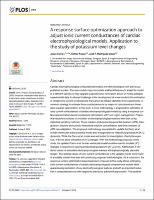Por favor, use este identificador para citar o enlazar este ítem:
https://repositorio.usj.es/handle/123456789/262
| Título : | A response surface optimization approach to adjust ionic current conductances of cardiac electrophysiological models. Application to the study of potassium level changes |
| Autor: | Carro, Jesús



Pueyo, Esther 


Rodríguez-Matas, José Félix 


|
| Palabras clave : | Modelos electrofisiológicos cardíacos; Corriente iónica |
| Fecha de publicación: | 3-oct-2018 |
| Editorial : | Agustín Guerrero-Hernandez, Cinvestav-IPN, MEXICO |
| Citación : | Carro J, Pueyo E, Rodríguez Matas JF (2018) A response surface optimization approach to adjust ionic current conductances of cardiac electrophysiological models. Application to the study of potassium level changes. PLoS ONE 13(10): e0204411. https://doi.org/10.1371/journal.pone.0204411 |
| Resumen : | Cardiac electrophysiological computational models are often developed from previously published models. The new models may incorporate additional features to adapt the model to a different species or may upgrade a specific ionic formulation based on newly available experimental data. A relevant challenge in the development of a new model is the estimation of certain ionic current conductances that cannot be reliably identified from experiments. A common strategy to estimate those conductances is by means of constrained non-linear least-squares optimization. In this work, a novel methodology is proposed for estimation of ionic current conductances of cardiac electrophysiological models by using a response surface approximation-based constrained optimization with trust region management. Polynomial response surfaces of a number of electrophysiological markers were built using statistical sampling methods. These markers included action potential duration (APD), triangulation, diastolic and systolic intracellular calcium concentration, and time constants of APD rate adaptation. The proposed methodology was applied to update the Carro et al. human ventricular action potential model after incorporation of intracellular potassium ([K+]i) dynamics. While the Carro et al. model was well suited for investigation of arrhythmogenesis, it did not allow simulation of [K+]i changes. With the methodology proposed in this study, the updated Carro et al. human ventricular model could be used to simulate [K+]i changes in response to varying extracellular potassium ([K+]o) levels. Additionally, it rendered values of evaluated electrophysiological markers within physiologically plausible ranges. The optimal values of ionic current conductances in the updated model were found in a notably shorter time than with previously proposed methodologies. As a conclusion, the response surface optimization-based approach proposed in this study allows estimating ionic current conductances of cardiac electrophysiological computational models while guaranteeing replication of key electrophysiological features and with an important reduction in computational cost with respect to previously published approaches. The updated Carro et al. model developed in this study is thus suitable for the investigation of arrhythmic risk-related conditions, including those involving large changes in potassium concentration. |
| URI : | https://repositorio.usj.es/handle/123456789/262 |
| ISSN : | 1932-6203 |
| Aparece en las colecciones: | Artículos de revistas |
Ficheros en este ítem:
| Fichero | Descripción | Tamaño | Formato | |
|---|---|---|---|---|
| journal.pone.0204411.pdf | 6,18 MB | Adobe PDF |  Visualizar/Abrir |
Este ítem está sujeto a una licencia Creative Commons Licencia Creative Commons

